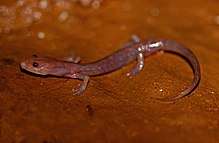Grotto salamander
The grotto salamander (Eurycea spelaea), also called the Ozark blind salamander, is a species of salamander in the family Plethodontidae. It is now considered a member of the genus Eurycea, but was originally described as Typhlotriton speleus.[1] It is endemic to the United States, specifically the karst regions beneath the Springfield and Salem Plateaus of the Ozark Mountains part of Arkansas, Kansas, Missouri, and Oklahoma.[1] Its natural habitats are freshwater springs, inland karsts, and caves. It is not currently threatened, but vulnerable to changes in groundwater quality and reduction in bat population.[1]
| Grotto salamander | |
|---|---|
 | |
| Scientific classification | |
| Kingdom: | Animalia |
| Phylum: | Chordata |
| Class: | Amphibia |
| Order: | Urodela |
| Family: | Plethodontidae |
| Genus: | Eurycea |
| Species: | E. spelaea |
| Binomial name | |
| Eurycea spelaea Stejneger, 1892 | |
| Synonyms | |
| |
The grotto salamander was discovered in 1891 on the Ozark Plateau, and described by Leonhard Hess Stejneger in 1892.[2] This plateau remains the only area in which grotto salamanders have been found.
Description
The larvae of this salamander are bold in coloration: brownish or purplish gray, sometimes with yellow flecks on the sides. Adults can grow up to 13.5 cm and larvae tend to be between 10 and 30mm.[3] They have a distinctive high tail fin and external gills. The larvae have functional eyes and may live outside of caves in brooks or streams. After two or three years, the larvae metamorphose, at which point they lose their gills, their eyelids fuse shut or at least partially shut, and the now blind adult form spends the rest of its life in a cave. The grotto salamander is the only cave salamander which undergoes metamorphosis. The adult form is pinkish white, sometimes with traces of orange on its tail, feet, and sides, and has 16–19 costal grooves.[4][5]
Distribution and habitat
The grotto salamander is found in caves and caverns throughout the Ozarks. They are known from at least 120 individual sites in Arkansas, 43 in Oklahoma and 25 in Missouri.[1][2] As larvae the grotto salamander lives in springs and streams near cave entrances.[1] As adults, They migrate deep into the caves themselves and live out their lives underground.[1] They prefer waters between 5.5 and 16.5 °C, and feed on small, cave-dwelling invertebrates such as Gammarus, though they are also known to eat guano as well.[2][3]
References
- Hammerson, Geoffrey (2004) Eurycea spelaea. In: IUCN 2012. IUCN Red List of Threatened Species. Version 2012.2.
- Graening, G. Fenolio, D. Slay, M. (2011). Cave Life of Oklahoma and Arkansas. University of Oklahoma Press, Norman. p. 7 ISBN 0806142235.
- Trauth, S. Robinson, H. Plummer, M. (2004) The Amphibians and Reptiles of Arkansas. University of Arkansas press. pp. 104–05 ISBN 1557287384.
- Conant, Roger, and Joseph T. Collins (1998) Peterson Field Guide to Reptiles and Amphibians Eastern/Central North America. 3rd ed. Houghton Mifflin Company, p. 498 ISBN 0395904528
- Behler, John L., and F W. King (1979). National Audubon Society Filed Guide to North American Reptiles and Amphibians. New York: Alfred A. Knopf, Inc, p. 356 ISBN 0394508246
